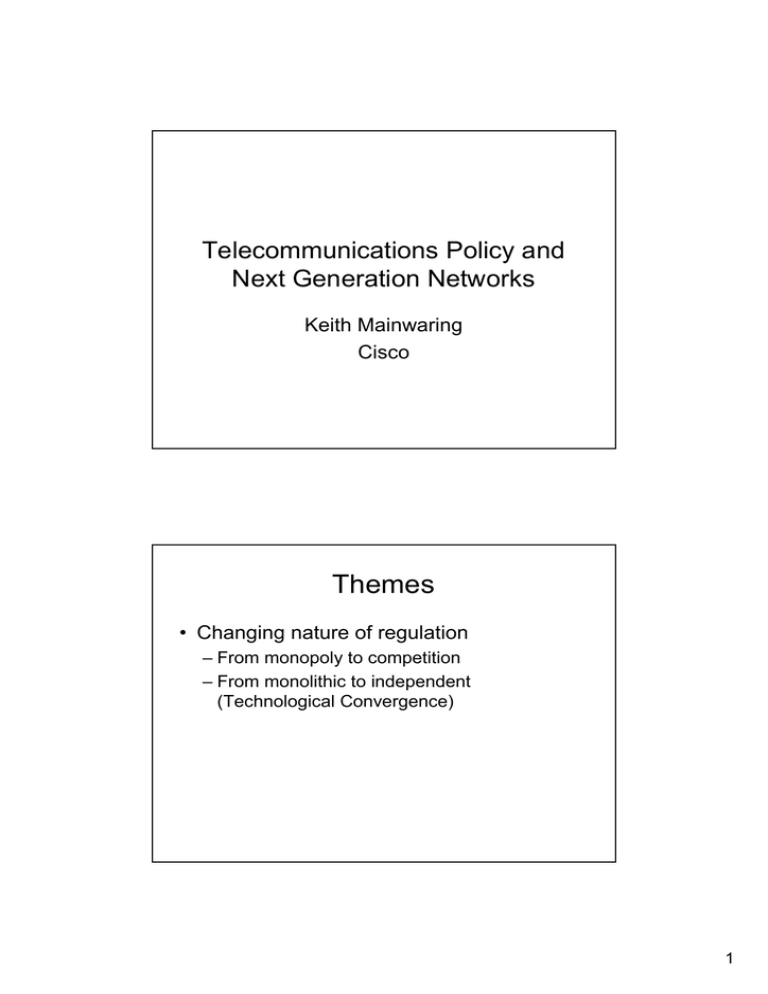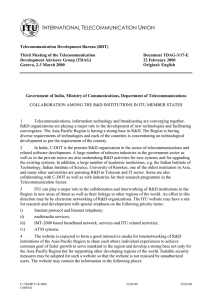Themes Telecommunications Policy and Next Generation Networks Keith Mainwaring
advertisement

Telecommunications Policy and Next Generation Networks Keith Mainwaring Cisco Themes • Changing nature of regulation – From monopoly to competition – From monolithic to independent (Technological Convergence) 1 What is regulation? • ”Regulation can be defined as the substitution of rules made by government for the competition of the market. Regulation can either involve setting the framework in which ... enterprises operate, or it can mean detailed intervention in their affairs through setting of their rates of return, or their tariffs or by decisions on which particular enterprises can enter a particular market, or what services may be offered.” Source: Jill Hills ”Deregulating Telecoms” Francis Pinter 1986. Aims of Regulation • Social – ”Safeguard those interests which the market cannot be expected to meet through the operation of the profit motive” • Examples: – Service in rural districts – Emergency services – Research & Development facilities – ”Externalities” – ”the unpleasant side-effects of profit making • Examples: – Safety – Pollution • Economic – Improve market performance • Example: – US anti-trust laws – Natural monopoly • ”where the economies of scale are such that to have more than one company in the market would increase units costs” and ”be detrimental to consumers” 2 Who benefits from regulation? • Consumers (some more than others?) • Regulated Industry • Regulatory Bureaucracy Criticism of Monoploy Regulation • • • • • • • • Does not benefit consumers Tariffs not cost-based & Cross-subsidies exist Wealth transfers should not be hidden Capital depreciation over a long period discourages innovation & reduction of costs Hard to see how efficiently network resources are being used Inflexible in meeting the needs of consumers Clientelism - regulatory agencies captured by the regulated operators Competition from other technological platforms 3 Privatisation ”privately owned companies have a greater incentive to produce goods and services in the quantity and variety which consumers prefer...Resources tend to be used as consumers dictate rather than according to the wishes of government, which must necessarily reflect short-term political pressures and problems of managing the public sector’s overall demands for capital.” Michael Beesley and Stephen Littlechild Competition rather than regulation? Perfect competition • Product homogeneity • Perfect knowledge • Lack of individual market power • Freedom of entry & exit • Existence of scale economies within the structure From John Buckley ”Telecommunications Regulation” IEE 2003. 4 Competition rather than regulation?(2) Fine in principle but: • Costs of market entry & exit • Access to existing infrastructure • Unprofitable services not provided • Consumer access costs may increase • Regulation to ensure fair play Aims of Regulation (2003) The ”primary purpose (of regulation) is to encourage, nourish and maintain competition in national and international telecommunications services markets.” John Buckley ”Telecommunications Regulation” IEE 2003. 5 Telecommunication market liberalisation Rebalancing of local & long distance call charges - Changes in the effective price of peak period calls in UK (BT) % 1984 1985 +6.8 +6.4 Local National ”a” National ”b1” National ”b” 1986 1987 1988 +18.9 +0.0 +0.0 +6.8 +6.4 +1.6 +0.0 +0.0 -10.3 -14.0 -12.0 +0.0 +0.0 -14.0 -6.2 -16.0 +0.0 +0.0 Source: OFTEL Annual Report 1988 International Telecommunication Regulations Accounting Rates “In the telecommunication sector, when an international telephone call passes from one country to another, the operator in the country that originates the call has traditionally made a compensatory payment to the operator in the country that terminates the call. These payments are made when traffic in one direction is greater that the traffic in the return direction. The level of payment is based on bilaterally negotiated "accounting rates". The so-called accounting rate regime is set out in the International Telecommunication Regulations (ITRs), an international treaty administered by the ITU, which was last updated in 1988. The ITRs are complemented by the "D-series" of Recommendations, which are the work of Study Group 3 of the ITU Telecommunication Standardization Sector.” http://www.itu.int/ITU-T/studygroups/com03/accounting-rate/index.html 6 Settlement payments “between 1993-98, net flows of settlement payments from developed counties to developing ones amounted to some US$40 billion” ITU/TeleGeography Inc. “Direction of Traffic: Trading Telecom Minutes”, ITU, Geneva, October 1999. US settlement payments - 1995 Region Africa Middle East Americas Asia-Pacific Western Europe Central& Eastern Europe Total Payment to foreign carrier (US$ million) Receipts from foreign carrier (US$ million) Net deficit (US$ million) 517 692 5732 3715 2945 302 524 3227 2124 1048 68 157 925 682 543 -234 -367 -2302 -1442 -505 489 309 95 -214 14130 7571 2472 -5099 Revenue (US$ million) 7 “Perhaps as much as half of all international traffic now passes outside the accounting rate system. Since 1998 the number of international voice circuits used for the Public Switched Telephone Network has been in decline on the busiest routes, for instance between North America and Europe, with private leased lines, which are used for carrying Internet Protocol traffic, now much more numerous. ” http://www.itu.int/ITU-T/studygroups/com03/accounting-rate/index.html May 2000 International Telecommunication Regulations • Current version: 1988 Melbourne • Accounting rate system revised 1998 • Recommendation D.140 - Accounting rate principles for the international telephone service – Rates to better reflect costs 8 Will shift to cost-based settlements decrease or increase payments to developing countries? Columbia (FCC data for 1996) • 61.5 million minutes to USA • 284.8 million minutes from USA • Columbia received settlement of US$ 0.70 / min for 223.3 million mins (20% of US$ 3.49 / min average revenue in USA) • Termination costs in developed countries normally greater than 20 % of total costs and even higher in developing countries • ”Columbia, and many other developing countries may find that when they shift to cost-based settlements, their net revenues increase instead of decrease.” Source: ITU Trends in Telecommunication Reform – Convergence & regulation 1999, p.107 Asymmetry of traffic flows • Greater for Internet than telephony e.g. USA to Mexico >US$ 1 billion (1996)* traffic ratio 2.9:1 (cf. Telmex’s revenue: US$ 8.5 billion (1998) • Internet traffic ratios commonly 10 – 20 :1 • Internet peering charges – reverse the direction of payment flows * “Internet for Development” ITU, 1999 9 Internet Peering • Conditions for settlement-free interconnection set by Tier 1 operators – e.g. http://www.verizonbusiness.com/uunet/peering/ • If not met full price of interconnection must be paid Long distance cost trends • Distance less important – Bandwidth more so – Applications such as IPTV & TelePresence • Prices tending towards actual costs • Costs are predominantly in origination & terminiation – Location based services – Customer Service and Customer Loyalty becoming more important (note that most mobile phones in Japan are branded by the operator, not the manufacturer) – Flat rates even for mobile services 10 “For the future, telecommunications network bandwidth capacity will be the primary factor determining the development of most new services and network investment requirements. Distance is becoming less & less significant….and the duration of network connections is growing in the direction of establishing permanent connections for some services.” ITU Trends in Telecommunication Reform – Convergence & Regulation 1999 11 Traffic growth on US & non-US routes: 2004-2005 IP Transit Prices New York “IP transit prices have fallen sharply since 2003. For example, the monthly price of a 155 Mbps port in New York City has fallen from $101 per Mbps in Q2 of 2003 to $29 per Mbps in Q2 of 2006, while the price of a comparable port in Hong Kong has fallen from $204 per month in Q2 2003 to $69 per month in Q2 2006.” 12 IP Transit – price decreases 2004 – 2005 2005 2006 US Change in Price Europe % -23 -33 -14 -23 -22 -23 Asia Source: TeleGeography: Global Internet Geography Trends - Privatisation Source: Trends in Telecommunications Reform 2006, ITU. 13 Trends - Competition Source: Trends in Telecommunications Reform 2006, ITU. Trends – Competition in basic services Source: Trends in Telecommunications Reform 2006, ITU. 14 Trends - Regulatory Authorities Source: Trends in Telecommunications Reform 2006, ITU. Technological Convergence VoIP Custom Ring Tones / MP3 Player High-Speed Internet /VPN Text / Instant Messaging Push-to-Talk / Intercom Video Conferencing Digital TV / VOD PDA / Email VOICE VIDEO DATA Device functionality is blurring... 15 Regulatory Traditions • • • Telecoms – Traditionally detailed regulation of basic telephony service – Historically de-jure or de-facto monopolies – Competition now widely regarded as best means of development – Regulation for universal service Internet – Developed without detailed control which has resulted in rapid growth – Social interests have become increasingly dependent on the Internet leading to demands for basic regulation – Regulation for confidence Media – Vertical integration of market – Well regulated – Regulation of content Regulatory Convergence • Malaysia 1998 • EU 2002 • Tanzania 2003 16 European Union Regulatory framework for electronic communications networks and services, including telecommunications, media and IT sectors • • • • Horizontal approach to regulation with homogenous treatment of all transport network infrastructure and associated services, irrespective of the types of service supported. Based on the distinction between the regulation of transmission and the regulation of content. General authorisation rather than licensing regime (i.e. an operator is obliged to notify the authorities but no investigation of the operation is to be required) No European Regulatory Authority – must be implemented in each member state – e.g. in UK: new Communications Bill and regulatory body – OFCOM – merging the functions of the 5 existing regulatory bodies: the Independent Television Commission (ITC), the Broadcasting Standards Commission (BSC), the Office of Telecommunications (Oftel), the Radio Authority (RAu) and the Radiocommunications Agency (RA) EU Regulatory Framework Aims: • to promote more effective competition; • to react to technological and market developments; • to remove unnecessary regulation and simplify associated administrative procedures; • to strengthen the internal market; and • to protect consumers. Policy for: • licensing and authorisations; • access and interconnection; • management of radio spectrum; • universal service; • user and consumer rights; • numbering, naming and addressing; • specific competition issues; and • institutional issues. 17 IP Telephony – Regulatory Issues • Should it be allowed? • Which aspects should be regulated? – As traditional voice service – Greater reliance on competition • Licencing obligations • Interconnection conditions Should IP Telephony be regulated as PSTN Telephony? • Different characteristics (e.g. delay) • Different service capabilities • Data network regulatory tradition 18 Is IP Telephony the same as PSTN Telephony? Characteristics differ • QoS – – Some initial quality problems but no longer significant issue in areas with good infrastructure Range of tools available – packet fragmentation on low bandwidth links, Diffserv, Resource Reservation, over-provisioning; EF-Admit: strict CAC for ETS calls under congestion • Services • • • Emergency calls Location information Security – – • • • • • Differences to PSTN/ISDN Techniques for defense in depth available - protecting at the edge of the network and within the network at multiple levels but still some issues (e.g. fraud based misuse of calling line identity) Undesirable traffic, SPAM & SPIT Not line powered Energy consumption Service availability / reliability Addressing and Routing (scaling issue) Issues Technical • Quality • Numbering • Location • Emergency Services • Interconnection • Fixed-Mobile Convergence • Undesirable traffic, SPAM & SPIT • Line powering • Energy consumption Policy • Universal service obligations • Investment incentives • Licensing conditions 19 Trends • Telecommunications market liberalisation • Privatisation & foreign direct investment rather than cash transfers • Technical innovations – mobility, greater bandwidth & the Internet • Tariffs tend towards costs • Separate regulation of services and infrastructure 20

